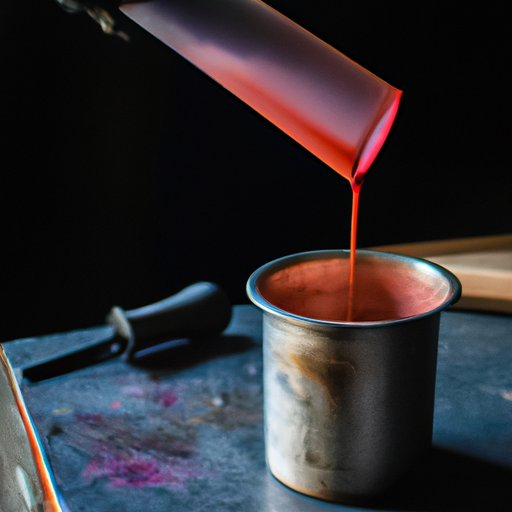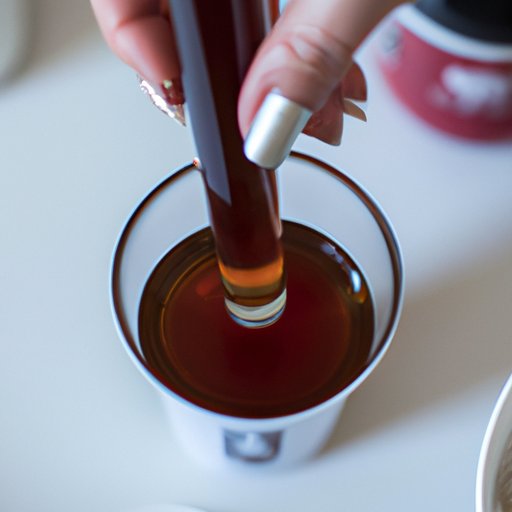
I. Introduction
Have you ever found yourself in the kitchen, needing brown food coloring but only having red, yellow and blue at your disposal? Fear not, as it is possible to make brown with food coloring. Food coloring is a great way to add vibrancy and life to your baked goods, whether it is frosting, macaroons, or cake batter. In this article, we will explore the different methods of making brown using food coloring.

II. Mixing Food Coloring for Homemade Brown: A Simple Guide
There are different types of food coloring available, such as gel, liquid, and powder. Gel food coloring is more concentrated and produces richer colors. Liquid food coloring is not as intense and can make thinner icings, while powder food coloring is a good option for coloring chocolate or dry mix recipes.
To make brown using food coloring, you need to mix complementary colors. In this case, red and green, blue and orange or yellow and purple make brown. You can experiment with different proportions of the colors to get the desired shade. A good starting point is mixing equal amounts of the complementary colors.
It is important to remember that the shade of brown you will get depends on the shades of the colors you are mixing. A darker shade of brown can be achieved by starting with darker shades of the complementary colors. Lighter shades of brown can be achieved by adding more of the lighter color to the mixture. Add the colors gradually so that you can determine the shade of brown you want.
III. Creating Brown from Primary Colors: A Beginner’s How-To
To create brown from primary colors, you need to understand the color wheel. The color wheel is a diagram that shows how different colors relate to each other. Primary colors are yellow, blue, and red. Mixing them together yields various secondary colors such as green, orange, and purple.
To create brown using primary colors, start with yellow, red, and blue. Mix the yellow and red together to create orange. Add blue to the orange mixture until you get a brown shade. It is essential to note the shade and intensity of the colors you are using to get the desired brown hue.
If you end up with a shade that is too light, add more blue to darken it. Conversely, if it is too dark, add more of the lighter colors (red or yellow) to lighten it. Keep adding the colors gradually to achieve the desired color.
IV. Achieving Natural Shades of Brown with Edible Dye
If you prefer using natural dyes instead of commercial food coloring, there are several options available. Natural dyes come from the natural pigments found in plants, fruits, and vegetables.
One way to create brown is by using cocoa powder. Cocoa powder is a natural ingredient that is easy to work with. It can be used to color frosting, cake batters, or cookies. Other food items that can be used for natural dyeing include coffee, tea, beetroot, turmeric, and caramel.
To extract the dye, boil the ingredients in water or milk over low heat for about twenty minutes, then strain. The resulting concentrate can be used to color your baked goods. A good rule of thumb is to add a little bit of concentrate at a time to achieve the desired shade, adding more until you reach the desired color or saturation.
V. Food Color Combos: The Secret to Perfect Brown Tones
Experimenting with color combinations can yield unique and beautiful shades of brown. Combining shades of red and green or orange and blue will produce rich brown hues. It is essential to understand that the shades of brown you will get depend on the intensity of the colors used in the combination.
For instance, combining a darker shade of green with a lighter shade of red will produce a reddish-brown color, while using a darker shade of red will produce a darker brown hue. Combine colors in small amounts, and when you achieve the desired shade, take note of the proportions used.
VI. From Light to Dark: Gradually Tinting Your Food for the Perfect Brown
Gradual tinting is the process of gradually adding color to a recipe. This technique enables you to achieve a natural look and can be used for recipes such as cake batters or pasta dough. Start by adding a small amount of color to the recipe, then keep adding until the desired shade is achieved.
For instance, when making pasta, you can add a little cocoa powder to your dough to make it brown gradually. This way, the pasta will have a natural, earthy look. The key to gradual tinting is to add small amounts of color at a time, compared to adding large amounts at once, which can result in over-coloring the recipe.
VII. Food Artistry 101: Creating Browns for All Occasions
Brown is an essential color in food artistry. It can set the tone for different occasions, such as Halloween, Thanksgiving, or Christmas. For Halloween, a darker shade of brown can be used to create spooky treats such as cupcakes with spiderweb designs. For Thanksgiving, a lighter brown shade can be used to create a turkey cake, while for Christmas, a lighter brown shade can be used for themed cookies.
When creating food art, it is important to consider the shade of brown you use and how it relates to the occasion. Experiment with different shades of brown using the techniques discussed above to find the perfect shade for your food artistry.
VIII. The Science of Creating Brown with Food Coloring
To understand how color mixing works, it is essential to understand the science behind it. The color wheel used in color mixing is based on the three primary colors of red, yellow, and blue. When these colors are mixed, they create secondary colors such as orange, green, and purple. Combining complementary colors creates brown.
The pH level of the food or the dye affects the final result of a color mixture. For example, red cabbage dye produces a blue shade in an alkaline solution, but it produces a red shade in an acidic solution. pH levels can affect the final shade of brown when using food coloring, so it is important to take note of the pH levels, especially when using natural dyes.
IX. Conclusion
Making the perfect shade of brown using food coloring is achievable, and with the right tools and tips, it can be done seamlessly. Whether you are creating baked goods for different occasions or experimenting with natural dyes, the key is to add the colors gradually and take note of the shades used, as this will help you achieve your desired shade of brown.





